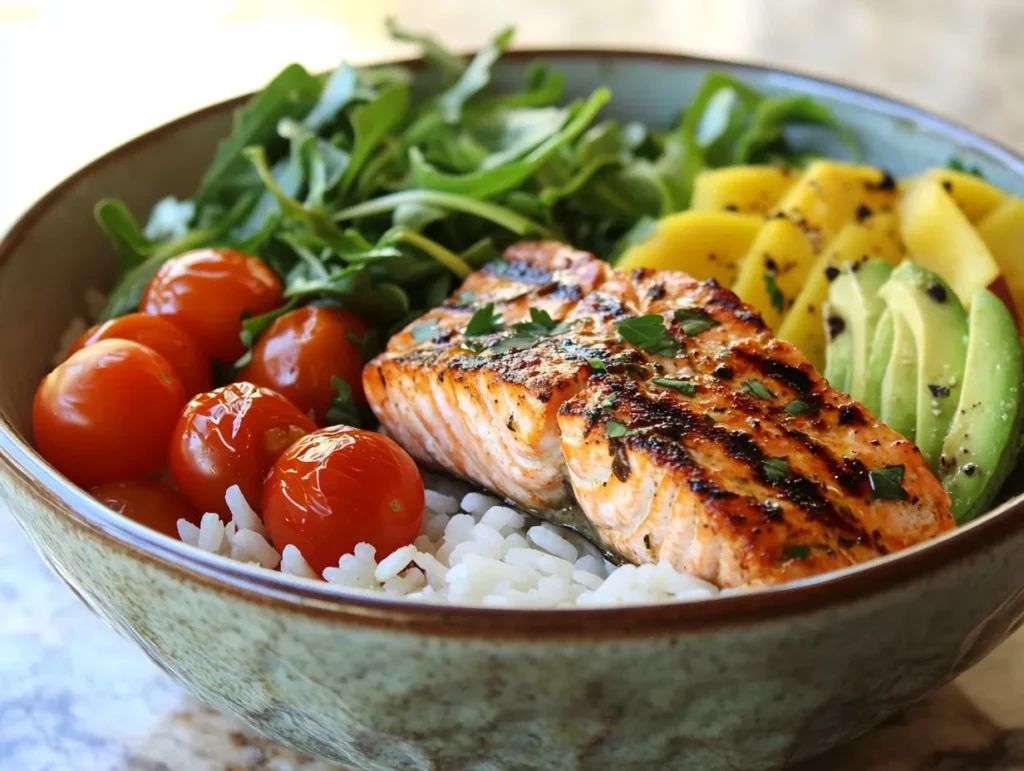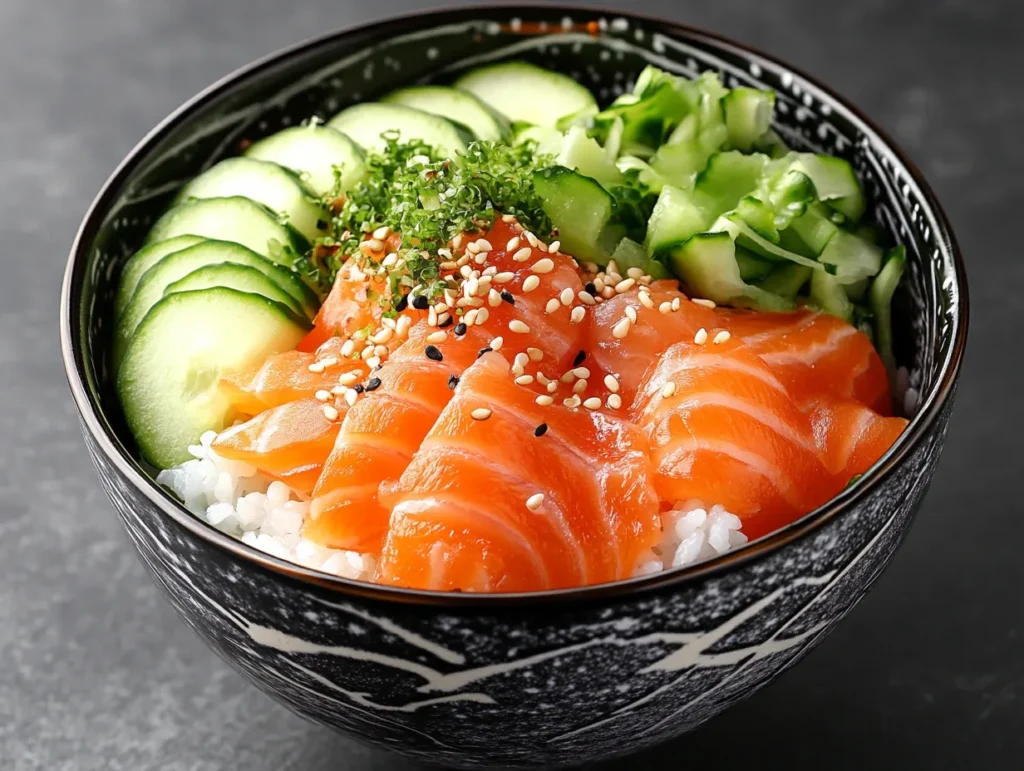
Introduction
Salmon bowls are healthy, delicious, and easy to make. They combine fresh salmon, vegetables, grains, and flavorful sauces. These bowls are popular with people who want quick and nutritious meals.
One reason they are loved is their versatility. You can mix different ingredients to create endless options. From light poke bowls to hearty grilled salmon bowls, there’s something for everyone.
In this article, you will learn all about salmon bowls. We’ll explore their health benefits, how to make them, and the best recipes to try.
What Are Salmon Bowls?
Definition and Key Ingredients
A salmon bowl is a dish that combines cooked or raw salmon with a mix of vegetables, grains, and toppings. The salmon can be grilled, baked, or served raw, depending on the style of the bowl. Key ingredients often include:
- A base: rice, quinoa, or greens.
- Fresh toppings: avocado, cucumber, or edamame.
- A sauce: soy, teriyaki, or spicy mayo.
Each ingredient works together to create a balanced and flavorful meal.
The Versatility of Salmon Bowls
Salmon bowls are very flexible. You can customize them to suit your tastes or dietary needs. For example, you can swap white rice for cauliflower rice or add extra veggies for a low-carb option.
They also work for different occasions. You can enjoy a light poke salmon bowl on a hot day or a warm grilled salmon bowl in colder months. This flexibility makes them a favorite for many people.
If you love raw salmon in your bowls, you might enjoy learning more about salmon sashimi, a Japanese delicacy that focuses on the pure flavor of fresh fish. Incorporating sashimi-style salmon into your bowl adds a light and refreshing touch.
Nutritional Benefits of Salmon Bowls
High in Protein
Salmon bowls are rich in protein, which is essential for building and repairing muscles. A single serving of salmon provides about 20-25 grams of protein. This makes it an excellent choice for those who want to stay full and energized throughout the day.
Packed with Omega-3 Fatty Acids
Salmon is a great source of omega-3 fatty acids. These healthy fats support heart health, reduce inflammation, and improve brain function. Adding salmon to your bowl is an easy way to include omega-3s in your diet.
A Balanced Meal
Salmon bowls often include grains and vegetables, making them a complete meal. Grains like rice or quinoa provide energy, while vegetables add fiber and vitamins. Together, they create a dish that is both satisfying and nutritious.
Types of Salmon Bowls
Poke-Style Salmon Bowls

Poke-style salmon bowls are inspired by Hawaiian cuisine. They feature raw, marinated salmon served over rice, often sushi rice. These bowls are fresh and light, making them perfect for warm days. Toppings like avocado, seaweed, and sesame seeds add extra flavor and texture.
Poke bowls are easy to customize. You can add spicy mayo for heat or swap rice for greens to make a low-carb version.
Grilled Salmon Bowls
Grilled salmon bowls are hearty and flavorful. The salmon is seasoned and cooked until it develops a crispy, caramelized crust. It’s then served over a base like quinoa or brown rice.
These bowls pair well with roasted vegetables, such as broccoli or sweet potatoes. A drizzle of lemon or tahini sauce ties everything together. Grilled salmon bowls are ideal for colder months when you crave something warm and comforting.
Teriyaki Salmon Bowls
Teriyaki salmon bowls offer a sweet and savory flavor. The salmon is glazed with a teriyaki sauce made from soy sauce, ginger, and sugar, then baked or pan-seared. The result is tender fish with a shiny, flavorful coating.
This type of bowl is often served with steamed rice, stir-fried veggies, and toppings like scallions or sesame seeds. It’s a great option for those who enjoy bold, Asian-inspired flavors.
How to Make the Perfect Salmon Bowl
Choosing the Right Salmon
The salmon you use can make or break your bowl. For raw dishes, such as poke bowls, always use sushi-grade salmon. This type of salmon is processed to be safe for eating raw.
For cooked bowls, fresh fillets work best. Look for salmon with bright orange color and no strong fishy smell. Wild-caught salmon has a richer flavor, but farmed salmon is often more affordable and widely available.
Tips for Cooking Salmon
Cooking this meal is simple if you follow these tips:
- Season lightly: Use salt, pepper, or marinades like teriyaki.
- Avoid overcooking: Cook the salmon until it flakes easily but remains moist.
- Choose the right method: Grilling, baking, or pan-searing are all great options.
Properly cooked salmon adds flavor and richness to your bowl.
Assembling Your Salmon Bowl
Assembling a salmon bowl is quick and fun. Follow these steps:
- Start with a base: Use rice, quinoa, or leafy greens.
- Add the salmon: Place your cooked or raw salmon on top of the base.
- Include toppings: Add veggies like cucumbers, avocado, or edamame.
- Finish with sauce: Drizzle soy sauce, spicy mayo, or teriyaki sauce for extra flavor.
Mix and match ingredients to create a bowl that suits your taste.
Flavor Combinations and Toppings
Popular Bases for Salmon Bowls
The base is the foundation of a good salmon bowl. Popular options include:
- Rice: Sushi rice, brown rice, or jasmine rice for a traditional feel.
- Quinoa: A protein-packed option for added nutrition.
- Leafy Greens: Spinach, kale, or arugula for a lighter, low-carb base.
Each base adds a unique texture and flavor, so you can choose one that fits your mood or dietary needs.
Tasty Sauces for Extra Flavor
Sauces are the secret to making salmon bowls exciting. Some favorites include:
- Soy Sauce: Adds a salty, umami kick.
- Teriyaki Sauce: Sweet and savory for bold flavor.
- Spicy Mayo: A creamy sauce with a hint of heat.
Drizzle the sauce over the bowl or serve it on the side for dipping.
Delicious Toppings to Enhance Your Bowl
Toppings add color, texture, and flavor to your bowl. Popular choices include:
- Avocado: Creamy and rich, perfect with salmon.
- Cucumber: Adds a fresh, crunchy bite.
- Sesame Seeds: A nutty topping that complements most sauces.
- Edamame: Protein-packed and slightly sweet.
- Pickled Ginger: Cleanses the palate and balances the flavors.
These toppings make each bite of your salmon bowl more enjoyable.
Best Places to Buy Salmon Bowls
Popular Restaurants for Salmon Bowls
Many restaurants serve delicious salmon bowls. Here are a few examples:
- Pokeworks: Known for fresh poke-style bowls with customizable toppings.
- Sweetgreen: Offers salmon bowls with a focus on fresh, seasonal ingredients.
- Local Japanese Restaurants: Often feature grilled or teriyaki salmon bowls on their menus.
These places are great for trying professionally made bowls with bold flavors.
Meal Delivery Services
If you prefer to enjoy salmon bowls at home, consider meal delivery services. Companies like Blue Apron and HelloFresh offer salmon bowl kits with pre-portioned ingredients. These kits make it easy to prepare a high-quality bowl in your own kitchen.
Store-Bought Options
For a quick and easy meal, many grocery stores sell pre-made salmon bowls. Look in the deli or frozen food section. These options are convenient for busy days when you want a healthy meal without cooking.
Homemade Salmon Bowl Recipes
Easy Grilled Salmon Bowl
Ingredients:
- 1 salmon fillet
- 1 cup cooked brown rice
- Steamed broccoli and carrots
- Lemon-tahini sauce
Instructions:
- Grill the salmon until it flakes easily.
- Place the brown rice in a bowl.
- Add the grilled salmon and steamed veggies.
- Drizzle with lemon-tahini sauce and serve.
Spicy Poke Salmon Bowl
Ingredients:
- 1 sushi-grade salmon fillet, diced
- 1 cup sushi rice
- Avocado, cucumber, and edamame
- Spicy mayo
Instructions:
- Marinate the diced salmon in soy sauce and sesame oil.
- Place the sushi rice in a bowl.
- Add the marinated salmon, avocado, cucumber, and edamame.
- Drizzle with spicy mayo and enjoy.
Asian-Inspired Teriyaki Bowl
Ingredients:
- 1 salmon fillet
- 1 cup jasmine rice
- Stir-fried veggies (peppers, snap peas)
- Teriyaki sauce
Instructions:
- Bake the salmon with teriyaki sauce until fully cooked.
- Place the jasmine rice in a bowl.
- Add the salmon and stir-fried veggies.
- Top with extra teriyaki sauce and sesame seeds.
How to Make Your Salmon Bowls Sustainable
Choosing Sustainable Salmon
Sustainability is essential when buying salmon. Overfishing and harmful farming practices can damage the environment. To make eco-friendly choices, look for:
- Wild-Caught Salmon: Certified by organizations like the Marine Stewardship Council (MSC).
- Responsibly Farmed Salmon: Look for labels like Aquaculture Stewardship Council (ASC) or Best Aquaculture Practices (BAP).
These certifications ensure the salmon is sourced responsibly, helping to protect marine ecosystems.
Eco-Friendly Packaging for Meal Prep
If you prepare the meal in advance, consider using sustainable packaging. Opt for:
- Glass Containers: Reusable and long-lasting.
- Biodegradable Bowls: Great for single-use meals.
- Reusable Wraps: Ideal for storing small portions of toppings or sauces.
Using eco-friendly materials reduces waste and helps the environment.
Supporting Sustainable Restaurants
When dining out, support restaurants that prioritize sustainability. Many places now highlight sustainable seafood options on their menus. Ask about their sourcing practices or look for information on their websites. By choosing these establishments, you encourage better practices in the food industry.
Frequently Asked Questions About Salmon Bowls
Can You Eat Salmon Bowls Cold?
Yes, salmon bowls can be eaten cold. Poke-style bowls are served cold and feature raw salmon, making them refreshing and light. If the salmon is cooked, let it cool before adding it to the bowl. This helps preserve the freshness of other ingredients like greens or avocado.
Are Salmon Bowls Gluten-Free?
Salmon bowls can be gluten-free, but it depends on the ingredients. Rice and vegetables are naturally gluten-free, but sauces like soy sauce may contain gluten. To make a gluten-free bowl, use tamari or coconut aminos as a substitute for soy sauce. Always check labels on sauces and toppings.
What Are the Best Sides for Salmon Bowls?
Salmon bowls are already complete meals, but you can serve them with sides to make them more filling. Popular options include:
- Miso soup
- Seaweed salad
- Steamed dumplings
These sides complement the flavors and add variety to your meal.
How Long Do Salmon Bowls Last in the Fridge?
Salmon bowls can last up to 2 days in the fridge if stored properly. Use an airtight container to keep the ingredients fresh. However, if the bowl contains raw salmon, it’s best to eat it within 24 hours for safety and quality.
Can You Use Canned Salmon for Salmon Bowls?
Yes, canned salmon can be used as a quick and budget-friendly option. It works well for cooked salmon bowls but may not have the same texture or flavor as fresh salmon. Choose high-quality canned salmon for the best results.
What Are Some Creative Toppings for Salmon Bowls?
If you want to get creative, try these unique toppings:
- Pickled radish for a tangy crunch.
- Nori strips for a salty, umami flavor.
- Fried onions for added texture and flavor.
These toppings can take your salmon bowl to the next level.
Conclusion
These are the perfect blend of health, flavor, and convenience. Whether you prefer a light poke bowl, a hearty grilled salmon bowl, or a flavorful teriyaki bowl, there’s a version for everyone. These versatile dishes are easy to make at home and can be customized to suit your taste and dietary needs.
By choosing sustainable salmon and eco-friendly practices, you can enjoy salmon bowls while supporting the planet. With endless combinations of bases, toppings, and sauces, the possibilities are limitless. Start creating your perfect salmon bowl today and enjoy this delicious, nutritious meal anytime.

